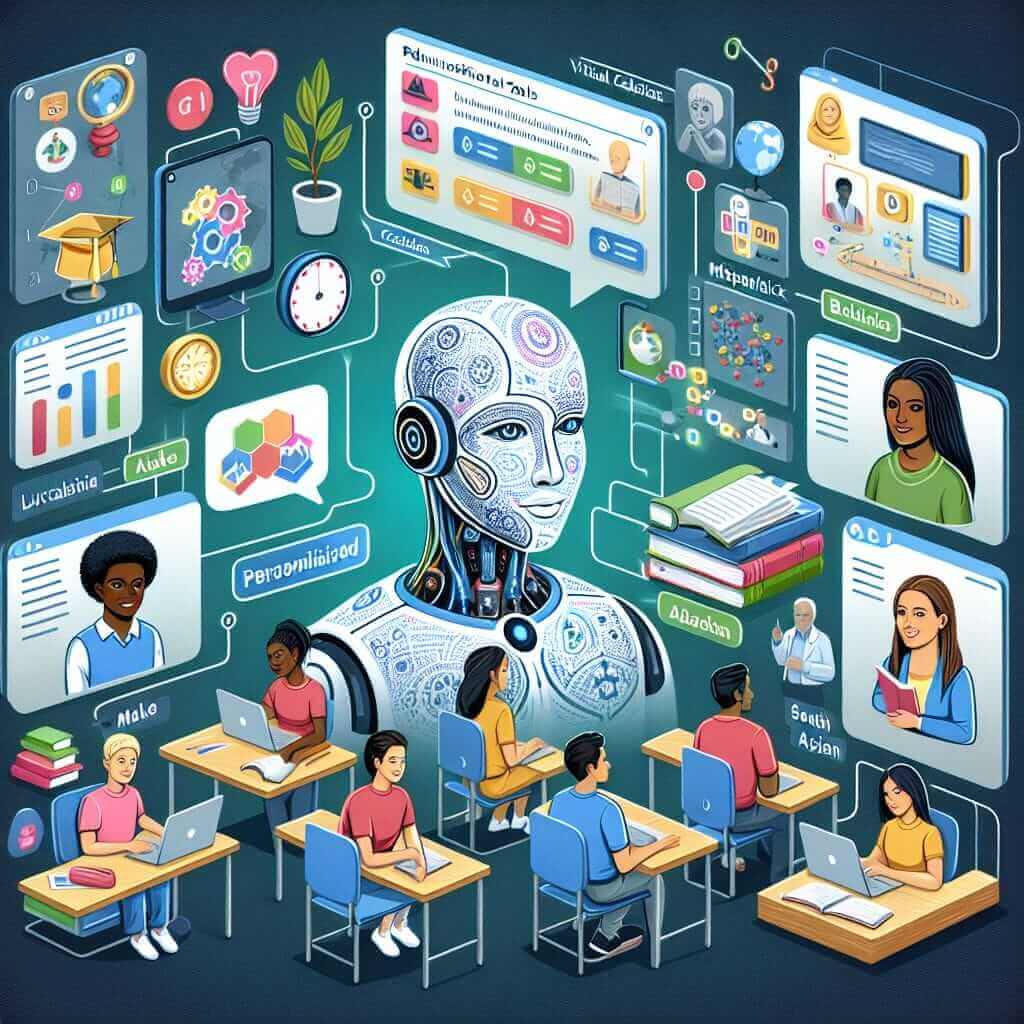The IELTS Reading test assesses various reading skills, including skimming, scanning, and overall comprehension. As AI continues to dominate various sectors, one increasingly prevalent topic is “How is AI being used in personalized learning systems?”. This subject is popular in educational discourse and could potentially appear in future IELTS exams due to its ongoing relevance. Understanding how AI personalizes education can provide insights into global education trends, enriching your IELTS preparation.
AI in Personalized Learning Systems: Reading Passage and Questions
Passage
Artificial Intelligence (AI) is transforming traditional educational models into dynamic, personalized learning systems. Utilizing data analytics and machine learning algorithms, AI tailors educational content to meet individual student needs, fostering an adaptive learning environment.
Firstly, AI-driven platforms assess a student’s current knowledge level through diagnostic tests, which identify strengths and weaknesses. Based on this data, AI creates customized lesson plans and interactive modules tailored specifically to each learner.
Moreover, AI tutors can provide instant feedback and step-by-step guidance, enabling students to progress at their own pace. These systems monitor student performance in real-time, adjusting the difficulty of tasks according to learner’s progress, thus maintaining an optimal learning curve.
Additionally, AI can identify learning patterns, predicting when a student is likely to struggle and intervening with personalized support. By analyzing vast datasets, AI systems detect and suggest improvements, offering a more efficient and engaging learning experience.
The integration of AI in classrooms is not without challenges. Issues such as privacy concerns, algorithmic biases, and the digital divide necessitate careful consideration. Nonetheless, AI’s potential to revolutionize education by making learning more personalized and accessible holds great promise.
Questions
Multiple Choice
-
What is one method AI uses to customize learning experiences for students?
- A. Assigning the same lessons to all students
- B. Creating lesson plans based on diagnostic tests
- C. Allowing students to choose their own lessons
- D. Randomly selecting educational content
-
Which of the following is a challenge in integrating AI in education?
- A. Lack of digital resources
- B. Uniform learning approaches
- C. Privacy concerns and algorithmic biases
- D. Over-reliance on traditional teaching
Identifying Information (True/False/Not Given)
-
AI systems cannot provide real-time feedback to students.
- A. True
- B. False
- C. Not Given
-
The digital divide is a consideration when implementing AI in education.
- A. True
- B. False
- C. Not Given
Sentence Completion
- AI-driven platforms can predict when a student is likely to and provide with personalized support.
Matching Features
-
Match the feature with its corresponding benefit:
-
(i) Real-time performance monitoring
-
(ii) Diagnostic assessments
-
(iii) Predictive analytics
-
A. Tailors lesson difficulty
-
B. Identifies strengths and weaknesses
-
C. Suggests improvements based on learning patterns
-
Answers and Explanations
-
1. B. Creating lesson plans based on diagnostic tests: AI analyzes diagnostic test results to tailor educational content, making this the correct choice.
-
2. C. Privacy concerns and algorithmic biases: These are significant challenges mentioned in the passage regarding AI integration in education.
-
3. B. False: The passage explicitly states that AI tutors can provide instant feedback, making this statement false.
-
4. A. True: The passage mentions the digital divide as one of the issues that need careful consideration.
-
5. struggle; intervene: AI systems predict when a student might struggle and intervene with personalized support.
-
6. (i) A, (ii) B, (iii) C: Real-time performance monitoring tailors lesson difficulty, diagnostic assessments identify strengths and weaknesses, and predictive analytics suggest improvements.
Common Mistakes and Tips
Common Mistakes
- Skimming and scanning improperly: Test-takers often miss crucial details by not practicing skimming and scanning techniques efficiently.
- Misinterpreting questions: Make sure to understand what each question type requires before answering.
- Time mismanagement: Allocate time wisely to avoid rushing through the text toward the end.
Vocabulary
- Transform (verb, /trænsˈfɔːrm/): To make a thorough or dramatic change in form, appearance, or character.
- Adaptive (adjective, /əˈdæptɪv/): Able to adjust to new conditions.
- Intervene (verb, /ˌɪntə(r)ˈviːn/): To come between so as to prevent or alter a result or course of events.
Grammar
Relative Clauses:
- Definition: Provide additional information about a noun without starting a new sentence.
- Example: “AI, which tailors educational content, fosters an adaptive learning environment.”
Recommendations
- Practice reading diverse articles on current and relevant topics.
- Familiarize yourself with common IELTS question types and practice them regularly.
- Enhance your vocabulary with specific themes, like educational technology and AI, to aid comprehension.
- Timely mock tests can help manage time effectively and build exam confidence.
For more insights on related topics, visit our article on how technology is transforming global education systems.

By understanding and anticipating the potential integration of AI in educational settings, you’re better prepared for the IELTS Reading section. Happy studying!